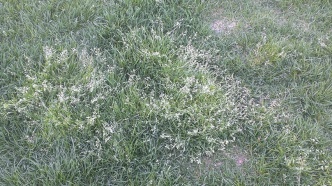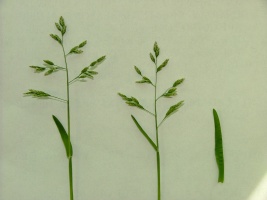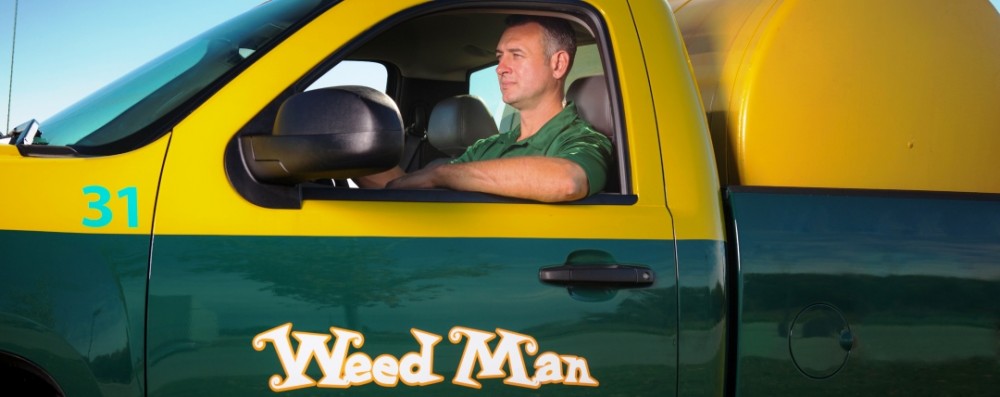“What is that awful looking wheat grass on my lawn?” is a question I get a lot when dealing with customers who have concerns over Annual Bluegrass.
On most home lawns there is a very common occurrence that takes place in the later part of the spring and earlier part of the summer, which is the Annual Bluegrass going to seed. This yearly occurrence can create some unsightly looking lawns not just because of all of the seed heads that shoot up but also because after the plant seeds set, the grass will turn yellow, discoloring the turf.
 In a perfect world, Kentucky Bluegrass would make up the majority of the grass on a lawn,
In a perfect world, Kentucky Bluegrass would make up the majority of the grass on a lawn,
as it has a deep blue color and is relatively drought-tolerant. Annual Bluegrass on the other hand, is really a weedy grass that is a winter annual or weak perennial and often dies during summer heat and drought, resulting in a lack-luster lawn. Almost every lawn will have some Annual Bluegrass in it, some may be taken over by it, and others will show signs of it but just in scattered areas or in unsightly patches.
The big question I get from homeowners after identifying the Annual Bluegrass and  determining we can’t control it with our broadleaf weed control, is “how did I get this and how can I get rid of it?” Believe it or not, the lawns that have the biggest problem with Annual Bluegrass are typically belong to homeowners that are over-managing their yards.
determining we can’t control it with our broadleaf weed control, is “how did I get this and how can I get rid of it?” Believe it or not, the lawns that have the biggest problem with Annual Bluegrass are typically belong to homeowners that are over-managing their yards.
One of the biggest contributors to Annual Bluegrass in the home lawn is mowing height. A lot of homeowners will want that golf course look to their lawn and they will end up cutting it way too short. Annual Bluegrass is very adaptive and can survive very low mowing heights. This is a huge issue for golf course superintendents, because it can even survive in low-mowed golf greens, creating an uneven putting surface (especially when it goes to seed).
In the home lawn however, when you cut the grass at a height of 2 inches or less, you will discourage the Kentucky Bluegrass that was sodded or seeded when the house was built. I always recommend cutting at a height of 3.5 inches, especially in the summer months, even considering it can tolerate a lower mowing height of 2.5 inches. However keeping it cut higher will keep it healthier, with deeper roots and thus discourage the Annual Bluegrass from germinating, as well as out-competing it.
Another possible factor of the growth of Annual Bluegrass is overwatering. I see a lot of homeowners that have irrigation systems programmed to go on every day for 20 minutes. Again, watering is important for your Kentucky Bluegrass, but it prefers deep watering around 1 inch to 1.5 inches per week. This may mean once or twice a week depending on the time of year and how much rainfall has occurred. Remember, early morning watering is best to discourage any disease as it allows the lawn to dry during the day.
The reality is, almost every lawn will have some Annual Bluegrass but what you do culturally will have a real effect on how much you’ll have to deal with. If you’re at that point where your lawn has the problem, then the best thing you can do is to bag your grass clippings. This will help prevent the seeds from going back into the soil. Although this may only have a small impact, as there are likely thousands of Annual Bluegrass seeds sitting dormant waiting for the right opportunity to germinate. Lastly, once the seeds are set, the turf will look a bit yellow. Saying this, keeping the turf as healthy as possible will help minimize the yellowing that will occur for a few weeks afterwards.
Questions about your lawn? Weed Man would be happy to help you. Find your local Weed Man using our locator map HERE.
Keep those lawns healthy,
Chris
